- Top Employee Onboarding Software
- Why Use Employee Onboarding Software?
- Key Features of Effective Onboarding Software
- How To Choose The Right Onboarding Software?
- Which is the Best Onboarding Software?
- Frequently Asked Questions (FAQs)
- What Is Upskill And Reskill?
- Difference Between Reskilling And Upskilling
- Upskilling for Workplace Advancement
- Reskilling for Career Transformation
- Crafting Successful Upskill and Reskill Strategies
- Upskill And Reskill Strategizing: Things to Keep in Mind
- Measuring the Impact of Skill Development Initiatives
- Frequently Asked Questions
- What’s a Skill Gap?
- Employee Skill Gap Analysis: Why Do We Need It?
- How To Conduct Employee Skill Gap Analysis?
- Addressing Skill Gaps Through Training and Hiring
- Utilizing Skills Gap Analysis for Strategic Planning
- Leveraging Employee Skill Gap Analysis: Things To Keep In Mind
- Frequently Asked Questions
- Transformative Role of AI in Talent Acquisition
- Impact of AI on Business Recruiting
- Overcoming Challenges in AI-Driven Talent Acquisition
- Starting with AI in Talent Acquisition
- Future Landscape of AI in Talent Acquisition
- Frequently Asked Questions
- HR In The Hot Seat - Challenges With Evolving Workforce
- Mastering Effective HR Management: Tips For Overcoming Challenges
- Summing Up
- The Future of HR: Key Trends for 2024
- Skill-Based Hiring
- Prioritizing Employee Experience, Engagement & Well-being
- AI-Empowered Workforce Evolution and Its Impact
- Taking Diversity, Equity, and Inclusion Beyond Mandates
- Hybrid and Remote Work
- Embracing the Gig Economy and Blended Workforce
- Transparent HR Practices
- Climate Change Adaptation in HR Practices
- Leveraging HR Analytics for Data-Driven Decisions
- Continuous Learning & Development to Improve Productivity
- The Office Buzz in 2024
- Bottom Line - HR Operating Model Needs A Shift
- Importance and Impact of Recognizing Employee Birthdays
- Professional Birthday Wishes for Employees (All Experience Levels)
- Personalized Birthday Wishes for Employees in Different Roles
- Fun Birthday Wishes for Employees (with Templates)
- Birthday Wishes for Remote Employees
- Heartfelt Birthday Wishes for Employees
- Belated Birthday Wishes for Employees
- Simple & Sweet Birthday Wishes for Employees
- Celebrating Employee Birthdays: Ideas and Traditions
- Tips and Ideas for Sending Birthday Wishes to Employees
- Closing Thoughts
- Frequently Asked Questions
- What Is An Employee Referral?
- Benefits of Implementing Employee Referral Programs
- Setting Up an Effective Employee Referral Program
- Employee Referral Email
- Employee Referral Scheme
- Overcoming Challenges of Employee Referrals
- Companies with Best Employee Referral Programs
- Employee Referral Programs: Best Practices
- Closing Thoughts
- Frequently Asked Questions (FAQs)
- Importance of Team Building Activities
- Types of Team Building Activities
- Outdoor Team Building Activities for Employees
- Indoor Team Building Activities for Employees
- Easy Team Building Activities for Remote Employees
- Team Building Activities For New Employees (Icebreakers)
- Fun Team Building Activities for Different Goals
- To Boost Communication and Collaboration
- To Reduce Stress Levels and Promote Well-being
- Aligning Team Purpose and Values with Strategic Activities
- Final Remarks
- Frequently Asked Questions
- Importance of Employee Appreciation Quotes
- Work Appreciation Quotes for Employees
- Employee Appreciation Quotes for Hard Work Recognition
- Employee Appreciation Quotes for Teamwork and Collaboration
- Appreciation Quotes for Celebrating Employee Anniversaries and Milestones
- Employee Appreciation Quotes for Strong Work Ethics
- Employee Appreciation Quotes for Project & Goal Completion
- Employee Appreciation Quotes for Quality of Work
- Employee Appreciation Quotes for Creativity and Innovation
- Appreciation Quotes for Managers
- Peer-to-Peer Employee Appreciation Quotes
- Appreciation Quotes for Employees Leaving the Company
- Employee Appreciation Quotes for Thoughtful Gestures
- Funny Employee Appreciation Quotes
- Short Employee Appreciation Quotes
- Employee Appreciation Quotes for Different Roles
- Employee Appreciation Quotes for Senior Leadership
- Creative Ways to Use Employee Appreciation Quotes
- Summary
- Frequently Asked Questions (FAQs)
- What is Employee Satisfaction?
- Importance of Employee Satisfaction
- Objectives of Employee Satisfaction
- Employee Satisfaction vs. Employee Engagement
- Key Reasons for Employee Dissatisfaction
- Strategies for Improving Employee Satisfaction
- Ways to Measure Employee Satisfaction
- Best Practices for High Employee Satisfaction
- Final Remarks
- Frequently Asked Questions (FAQs)
- How to Craft Effective Employee Appraisal Comments
- Key Areas to Focus in Performance Review
- Comments On Hard Work & Dedication
- Assessing Interpersonal Skills
- Evaluating the Ability to Collaborate & Work in Teams
- Gauging Punctuality
- Commenting on Communication Style
- Reviewing Time Management and Productivity
- Leadership in Performance Appraisals
- Assessing Creativity & Innovation
- Evaluating Problem-Solving Abilities
- Recognizing Flexibility and Dependability in Reviews
- Employee Appraisal Comments for Different Roles
- Summary
- Frequently Asked Questions (FAQs)
- Employee Grievance Meaning
- Importance of Employee Grievance Process
- Types of Workplace Grievances
- Reasons for Employee Grievances
- Employee Grievance Procedure
- Steps in the Employee Grievance Handling Process
- Employee Grievance Form Example
- Final Remarks
- Frequently Asked Questions (FAQs)
- What is Company Culture?
- Importance of Company Culture
- Types of Company Culture
- Factors Contributing to Organizational Culture
- Assessing & Developing Corporate Culture
- Company Culture - It’s not just Perks or Feels
- Good Company Culture Examples
- Developing Company Culture: Best Practices
- Closing Thoughts
- Frequently Asked Questions (FAQs)
- What is Employee Empowerment?
- Benefits of Empowering Employees
- Employee Empowerment vs. Micromanagement
- Strategies for Effective Employee Empowerment
- Role of Managers in Fostering Empowerment
- Organizational Structure Supporting Empowerment
- Overcoming Barriers to Employee Empowerment
- Frequently Asked Questions (FAQs)
- What is Employer Branding?
- Importance of Employer Branding Strategy
- How to Build an Employer Branding Strategy?
- Strategies for Building a Strong Employer Brand
- How to Measure and Boost Your Employer Branding Success?
- Examples of Strong Employer Brand Strategy
- Best Practices for an Effective Employer Branding Strategy
- Closing Thoughts
- Frequently Asked Questions (FAQs)
- What are Employee Wellness Programs?
- Importance of Employee Wellness Programs
- Examples of Employee Wellness Programs
- Real-Life Examples of Corporate Wellness Programs
- Strategies for Encouraging Participation
- Supporting Diverse Employee Needs
- Creating Comprehensive Wellness Programs
- Measuring the Impact on Business and Employees
- Closing Thoughts
- Frequently Asked Questions (FAQs)
- What is Talent Management?
- Developing a Winning Talent Management Strategy
- Models and Frameworks
- Tips for Framing Effective Talent Management Strategy
- Looking Ahead: Recent Trends in Talent Management
- Frequently Asked Questions
- Role of AI in HR: Addressing Common Challenges
- Artificial Intelligence in HR Processes
- AI Tools for HR Functions
- How to Adopt AI in HR?
- Addressing Challenges of AI in HR
- Ethical and Responsible AI Use
- The Future of AI in HR
- Closing Thoughts
- Frequently Asked Questions
- What is Performance Management?
- Elements of Effective Performance Management
- Performance Management Cycle
- Differentiating Performance Management
- Benefits of Performance Management With Examples
- Challenges faced in Performance Management and their Solutions
- Future Trends in Performance Management
- Frequently Asked Questions
- Changing Role of HRM
- Changing Role Of HR Manager
- Technology and the Changing Role of HRM
- The Rise of AI and Machine Learning in HR
- Mobile Technology's Impact on HR Practices
- The Significance of People Analytics in HR
- Navigating the Future of HR Technology
- Final Remarks
- Frequently Asked Questions
- Compensation Management Meaning
- Compensation Types
- Breaking Down The Compensation Management Process
- HR Software for Compensation Management
- Current Trends in Compensation Management
- Frequently Asked Questions
- Defining Flexible Work Arrangements
- Flexible Working: Advantages for Businesses
- Challenges of Flexible Work Arrangements
- Crafting Flexible Working Practices
- Types Of Flexible Work Arrangements
- Comparing Flexible Work Arrangements
- Real-Life Examples of Flexible Work Arrangements
- Final Remarks
- Frequently Asked Questions
- Conflict Resolution Meaning
- Conflict Origins
- Tried & Tested Conflict Resolution Strategies
- Methods of Conflict Management at Workplaces
- Conflict Resolution Strategies: Top Management Tips
- Summary
- Frequently Asked Questions
- Career Development Meaning
- Career Development Plan for Employees
- Career Development in HRM: Growth Ideas For Employees
- Issues in Career Development and Their Solutions
- Closing Thoughts
- Frequently Asked Questions
- Understanding Compensation
- Exploring Benefits
- Difference between Compensation and Benefits
- Compensation & Benefits Structure
- Final Remarks
- Frequently Asked Questions
- Defining Recruitment in HR Practices
- Exploring Talent Acquisition in HR
- Understanding Talent Acquisition vs Recruitment
- When to Recruit or Acquire Talent
- Talent Acquisition vs Recruitment: Responsibilities
- From Recruitment To Talent Acquisition
- Closing Thoughts
- Frequently Asked Questions
- Work Culture Meaning
- Types of Work Cultures
- Components of Culture
- Best Work Culture Examples Set By Top Companies
- Creating a Positive Work Culture
- Closing Thoughts
- Frequently Asked Questions
- Defining Learning vs Development
- Importance of Learning and Development
- L&D Activities for Employees
- Choosing the Right L&D Activities
- Crafting an Effective L&D Strategies
- Aligning L&D Strategy with Business Goals
- Designing Engaging Learning Journeys
- Learning and Development Process: KPIs
- ROI in Learning and Development
- Emerging Trends in L&D
- Closing Thoughts
- Frequently Asked Questions
- What Is Leadership Development?
- Key Skills for Leaders
- How To Develop Leadership Skills in Organizations?
- What Is A Leadership Development Program?
- How To Develop A Leadership Development Program?
- Example of A Leadership Development Plan
- Benefits of Leadership Development Training
- Frequently Asked Questions
- Defining Diversity Training
- Importance of Diversity Training
- What are the Types of Diversity?
- Types of Diversity Training Methods
- Diversity Training Activities
- Choosing A Diversity Training Program
- How to Implement Diversity Initiatives
- Best Diversity Training Programs (Real-Life Examples)
- Improving the Effectiveness of Diversity Training
- Tracking and Evaluating the Results of DE&I Training Efforts
- Essential Elements for Successful Diversity Training
- Closing Thoughts
- Frequently Asked Questions
- Defining Occupational Health & Safety
- Evolution of Workplace Health and Safety
- Identifying Common Workplace Hazards
- Global Impact on Occupational Health & Safety
- Managing Employee Health and Safety Risks
- Occupational Health and Safety Problems
- Future of Occupational Health and Safety
- Frequently Asked Questions
- Employee Orientation Defined
- Employee Onboarding Explained
- Orientation and Onboarding: Understanding the Difference
- Importance of Orientation and Onboarding
- Crafting Comprehensive Integration Strategies
- Quick Tips for Orientation and Onboarding
- Frequently Asked Questions
- What is HR Metrics?
- Importance of HR Metrics
- HR Metrics Examples in Recruitment
- HR Metrics Examples in Employee Retention
- HR Metrics Examples in Revenue
- Other Common HR Metrics
- Soft HR Metrics Example
- HR Metrics Formula
- Utilizing HR Metrics Effectively
- Future of HR Metrics
- Summary
- Frequently Asked Questions
- Defining Decision Making Process
- Key Concepts In Decision Making
- Decision Making & Problem Solving
- Tips For Improving Decision Making Skills
- Selected Practice Questions & Answers
- Conclusion
- Frequently Asked Questions (FAQs)
- A case(s) of miscommunication
- The devil is in the (resume) details
- One for the complaints!
- What is an Exit Interview?
- Benefits of Exit Interviews to an Organization
- How to Conduct Exit Interviews?
- Exit Interview: Sample Questions to Ask
- Overcoming Challenges of Exit Interviews
- Exit Interviews: Best Practices
- Closing Thoughts
- Frequently Asked Questions
- Technology in the Workplace
- Benefits of Tech Integration
- Technology in the Workplace: Key Functions
- How Technology Normalized Remote Work
- Workplace Technology: Top Tools and Software
- Steps for Effective Technology Implementation
- Overcoming Tech Implementation Challenges
- Ethical Considerations in Tech Use
- Keeping Pace with Tech Trends
- Closing Thoughts
- Frequently Asked Questions
- What is Ethical Leadership?
- Principles of Ethical Leadership
- Difference between Ethics and Integrity
- Importance of Ethical Leadership
- Ethical Leadership in Practice
- Overcoming Challenges
- Frequently Asked Questions
- Embracing Change Management
- Mastering People Analytics
- Enhancing Stakeholder Relationships
- Navigating Diversity, Equity & Inclusion
- Upholding Ethics and Data Privacy
- Developing Critical Thinking
- Advancing Negotiation Techniques
- Fostering Inter-departmental Collaboration
- Building Resilience in HR
- Frequently Asked Questions
- What is Mental Health?
- Benefits of a Mentally Healthy Workforce
- Prioritising Mental Health: Creating a Culture of Support
- Final Remarks
- Frequently Asked Questions
- Gen Z vs Millennials - What is the difference?
- Retain and Engage Gen Z Employees: Need and Strategies
- Strategies to Retain and Engage Gen Z Employees
- Rethinking Requirements
- Final Remarks
- Frequently Asked Questions
- Understanding Millennial Leadership Needs
- Key Leadership Skills for Millennials
- How To Develop Millennial Into Leaders
- Additional Strategies to Develop Leaders
- Learning Preferences of Millennials
- Benefits of Investing in Millennial Leaders
- Closing Thoughts
- Frequently Asked Questions
- Understanding Fluff
- Examples of Interview Fluff
- Identifying Interview Fluff
- Addressing Interview Fluff
- Seeing Through the Fluff
- Frequently Asked Questions
- What is the Gender Pay Gap?
- Is the Gender Pay Gap Real?
- Factors Affecting the Gender Pay Gap
- How Age Impacts Women’s Earnings
- The ‘Motherhood Penalty’
- Education's Role in Wage Differences
- Racial and Ethnic Disparities in Pay
- Closing the Gender Gap
- Frequently Asked Questions
- Top Weirdest Late-To-The-Office Excuses
- The Fine Art of Balancing Wit and Wisdom in HR
- Understanding Social Media Recruiting
- Crafting Your Social Media Recruitment Strategy
- Implementing Your Strategy Effectively
- Popular Platforms for Recruitment
- Navigating the Downsides of Social Media Recruiting
- Measuring Success and Adjusting Strategy
- Summary
- Frequently Asked Questions
- Who Is A High Potential (HIPO) Employee?
- Characteristics of A High Potential (HIPO) Employee
- High Potential Employee Identification
- Grooming High Potential Employees
- Why High Potential Employees Leave
- How Do You Retain High Potential Employees?
- High Potential Employee Development: Best Practices
- Closing Thoughts
- Frequently Asked Questions
- What is Digital Fluency?
- Why Digital Fluency Matters?
- Difference between Digital Literacy and Digital Fluency
- Key Components of Digital Fluency
- Achieving Digital Fluency
- Overcoming Challenges
- Future of Workforce Digital Fluency
- Frequently Asked Questions
- What is Loud Quitting?
- Pros and Cons of Loud Quitting
- Reasons Behind the Trend
- Analyzing the Impact
- How HR Can Navigate the Loud Quitting Uproar
- Preventive Strategies
- Closing Thoughts
- Frequently Asked Questions
- Defining Emotional Intelligence in HR
- Why Emotional Intelligence Matters for HR Leaders
- How To Build Emotional Intelligence in HR
- Integrating EQ into HR Practices
- Impact of EQ on Company Culture
- Emotional Intelligence in HR: Major Challenges
- Final Remarks
- Frequently Asked Questions
- Understanding Internal Job Posting
- Internal Job Posting: Pros and Cons
- The Internal Job Posting Process
- Writing Effective Ads for Internal Job Posting
- Strategies for Success of Internal Job Posting
- Summary
- Frequently Asked Questions
- Understanding Workplace Bias
- Common Types of Bias in HR
- Closing Thoughts
- Frequently Asked Questions
- What is a Dry Promotion?
- Dry Promotion: Pros and Cons for Companies
- Impact of Dry Promotion on Employee Retention
- Preventing Talent Loss After Dry Promotions
- Closing Thoughts
- Frequently Asked Questions
- What Is A Stay Interview?
- Importance Of Stay Interviews
- Benefits And Challenges Of Stay Interviews
- Planning And Conducting Stay Interviews
- Stay Interviews: 20 Sample Questions To Ask
- Best Practices For Effective Stay Interviews
- Summary
- Frequently Asked Questions
- Who Is A Boomerang Employee?
- Reasons For Returning
- Benefits Of Hiring Boomerang Employees
- Challenges Of Rehiring
- Interviewing Boomerang Candidates: Sample Questions
- Enhancing The Hiring Process
- Making Informed Decisions
- Final Remarks
- Frequently Asked Questions
- Talent Pipeline Meaning
- Significance of Talent Pipelines
- Advantages of a Talent Pipeline
- Building a Talent Pipeline
- Maintaining a Talent Pipeline
- Attracting Top Talent
- Implementing the Strategy
- Frequently Asked Questions
- What is Micromanagement?
- Recognizing Micromanagement
- Leadership versus Micromanagement
- Keeping Micromanagement in Check
- Beyond Micromanagement
- Summing Up
- Frequently Asked Questions
- Recognizing Signs Of A Bad Hire
- Understanding The Impact On Teams
- Dealing With A Bad Hire
- Preventing Future Bad Hires
- Closing Thoughts
- Frequently Asked Questions
- Defining Neurodiversity
- Importance of Neurodiversity in the Workplace
- Moving Towards Inclusive Environments
- Final Remarks
- Frequently Asked Questions
- Understanding the Generation Gap
- Multigenerational Workforce: Debunking Stereotypes
- Strategies for Bridging the Gap
- Benefits of a Multigenerational Workforce
- Final Remarks
- Frequently Asked Questions
- Defining Productivity Theatre: All Show, No Go
- 5 Key Drivers of Fake Productivity
- Solutions to Combat Productivity Theatre
- Summary
- Frequently Asked Questions
- Defining Grumpy Staying
- Why do Grumpy Stayers not Leave?
- Recognizing the Signs
- Exploring the Causes
- Understanding the Impact
- Addressing the Issue
- Taking Action: Addressing Grumpiness with Empathy
- After the Conversation
- When Grumpy Staying Continues
- Closing Thoughts
- Frequently Asked Questions
- The Rationale Behind Office Peacocking
- Impact on Company Culture
- Impact on Employees
- Case Studies: Examples of Office Peacocking
- The Downside: Potential Pitfalls of Office Peacocking
- Practical Tips for Implementing Office Peacocking
- Frequently Asked Questions
- 13 Common Mistakes Young Managers Make
- Strategies To Avoid Mistakes (Individual Growth)
- How Young Managers Can Boost Teamwork
- Learning From Errors
- Summary
- Frequently Asked Questions
- Understanding Great Regret - What causes the shift shock?
- Impact of Great Regret
- How can HR help make the situation better?
- Closing Thoughts
- Frequently Asked Questions
- Understanding the HR Budget
- Key Components of an HR Budget
- Preparing an HR Budget Step-by-Step
- Importance of HR Budgeting in Management
- Final Remarks
- Frequently Asked Questions
- What are Pre-Employment Assessments?
- Importance of Pre-Employment Testing
- Types of Pre-Employment Assessments
- 15 Tips for Creating Effective Pre-Employment Assessments
- Closing Thoughts
- Frequently Asked Questions
- Exploring the Productivity Paradox
- Understanding the Impact of Solow Paradox
- Productivity Paradox: Why it Matters for Recruiters & HRs
- Identifying Causes and Challenges
- Strategies for Enhancing Productivity
- AI & the Modern-Day Productivity Paradox
- Beyond Technology: Building a Productive Workforce
- Summary
- Frequently Asked Questions
- Understanding the Great Reshuffle 2.0
- Preparing Leaders for the Change
- HR’s Role in Handling Great Reshuffling 2.0
- The Way Ahead
- Frequently Asked Questions
- Definition Of Managerial Grid
- Managerial Grid Theory Explained
- Application Of Managerial Grid
- Criticisms And Limitations
- Evolution And Contemporary Perspectives
- Integrating Managerial Grid With Other Models
- Practical Steps For Implementing Managerial Grid
- Conclusion
- Frequently Asked Questions
- Understanding Skills Taxonomy
- Why do we Need Skills Taxonomy?
- Benefits of Skills Taxonomy
- Components of Skills Taxonomy
- Building a Skills Taxonomy: A Step-by-Step Guide
- Skill Taxonomies vs Intelligence Tools
- Closing Thoughts
- Frequently Asked Questions
- Definition Of Team Building
- Stages Of Team Development
- Top 10 Strategies For Effective Team Building
- Team Building Activities
- Best Practices For Effective Team Building
- Setting Team Building Objectives
- Challenges In Team Building
- Conclusion
- Frequently Asked Questions (FAQs)
- Defining Job Shadowing
- Unpacking the Benefits
- Setting Up the Experience
- Job Shadowing vs Internship
- Dos and Don'ts for HR Professionals
- Closing Thoughts
- Frequently Asked Questions
- Employee Journey Mapping: Meaning & Importance
- Stages of the Employee Journey
- Steps for Effective Mapping
- Employee Journey Map: Where does it begin?
- Employee Journey Map: Template
- Best Practices & Tips
- Summary
- Frequently Asked Questions
- Why are Performance Appraisals needed?
- Evolution of Performance Management
- Modern Performance Practices
- Benefits of Modern Performance Appraisals
- The Future
- Frequently Asked Questions
- Is Experience the Sole Indicator of Success?
- Why Hire Inexperienced Talent?: Key Advantages
- Skills to Look For in Inexperienced Talent
- Challenges and Considerations in Hiring Inexperienced Talent
- Final Remarks
- Frequently Asked Questions
- What is a Company Retreat?
- Company Retreat Ideas: Team-Building & Exploration
- Relaxation and Celebration
- Planning Your Retreat: Things to Keep in Mind
- Closing Thoughts
- Frequently Asked Questions
- Understanding HR Forecasting
- HR Forecasting Key Concepts
- Steps for Implementing HR Forecasting
- Common HR Forecasting Methods
- Closing Thoughts
- Frequently Asked Questions
- What is ESG?
- HR and ESG - Why Care?
- ESG in HR Strategy
- Challenges for HR
- Future of ESG in HR
- Frequently Asked Questions
- Defining the Great Betrayal
- Reasons for Its Spread
- Impact on Workers
- Impact on Corporations
- Rebuilding Trust & Valuing Employees
- Closing Thoughts
- Frequently Asked Questions
- Importance of Clear Expectations
- Setting Expectations Early
- Communicating Expectations Effectively
- Differentiating Expectations
- Reviewing and Adjusting Expectations
- Summing Up
- Frequently Asked Questions
- Understanding KRA Frameworks And Models
- KRAs vs KPAs and KPIs
- Monitoring and Tracking KRAs
- KRAs in Various Roles
- Impact of KRA Frameworks and Models on Organizational Success
- Frequently Asked Questions
- Where: The Place of Work
- When: The Time of Work
- How Much Work: Alternate Employment Models
- Who Does the Work: Intelligence
- Designing Organizations with the Four Dimensions of Work
- Summing Up
- Simplifying Processes: The Foundation of Efficiency
- Reducing Unnecessary Meetings: Reclaiming Valuable Time
- Building Strong Accountabilities: Ensuring Responsibility
- Role of HR in Addressing Inefficiencies
- Continuous Improvement: A Commitment to Excellence
- Leadership's Role in Driving Efficiency
- Conclusion: A Holistic Approach to Efficiency
- Understanding Financial Freedom
- Benefits of Empowering Employees Financially
- Empowering Employees Through Financial Literacy
- Financial Topics That Need Attention Based On Career Stage
- Summing Up
- Frequently Asked Questions
- Defining Employee Voice
- Benefits of Amplifying Employee Voice
- Strategies and Tools
- Encouraging Participation
- Closing Thoughts
- Frequently Asked Questions
- Appraisal Blues: Signs of Unhappy Employees
- Addressing Unhappiness Post-Appraisal
- Non-Monetary Solutions for Dissatisfied Employees
- Summing Up
- Frequently Asked Questions
- Women in the Middle Eastern Workforce
- Importance of DEIB
- Role of HR in Building Inclusive Workplaces for Women
- Measuring Inclusion Progress: Key Metrics
- Closing Thoughts
- Frequently Asked Questions
- Preparing for the Conversation
- Conducting the Conversation
- Best Practices for the Talk
- After the Conversation
- Helping Employees Grow
- Frequently Asked Questions
- Understanding HR Exhaustion
- Factors Leading To HR burnout
- Impact Of HR Burnout
- Strategies To Prevent And Manage HR Burnout
- Role Of Technology In Preventing Burnout
- Celebrating HR Successes
- Summary
- Frequently Asked Questions
- Common Mistakes When Hiring Young Talent
- Building Connections with Candidates
- Summary
- Frequently Asked Questions
- Walking a mile in the employee’s shoes
- Conducting Humane Layoffs
- Remote Layoffs Management
- Supporting Laid-off Workers
- Managing the Aftermath
- Wrapping Up
- Frequently Asked Questions
- Importance of Shortening Time-to-Hire
- Shortening Hiring Time: Pre-Application Stage
- Reducing Hiring Time: Application Stage
- Hacks to Shorten Hiring Time: Interview Stage
- Reducing Hiring Time: Offer Stage
- 5 Other Important Hacks & Strategies
- Final Remarks
- Frequently Asked Questions
Upskill And Reskill: The Learning Approaches Shaping Professional Development Today
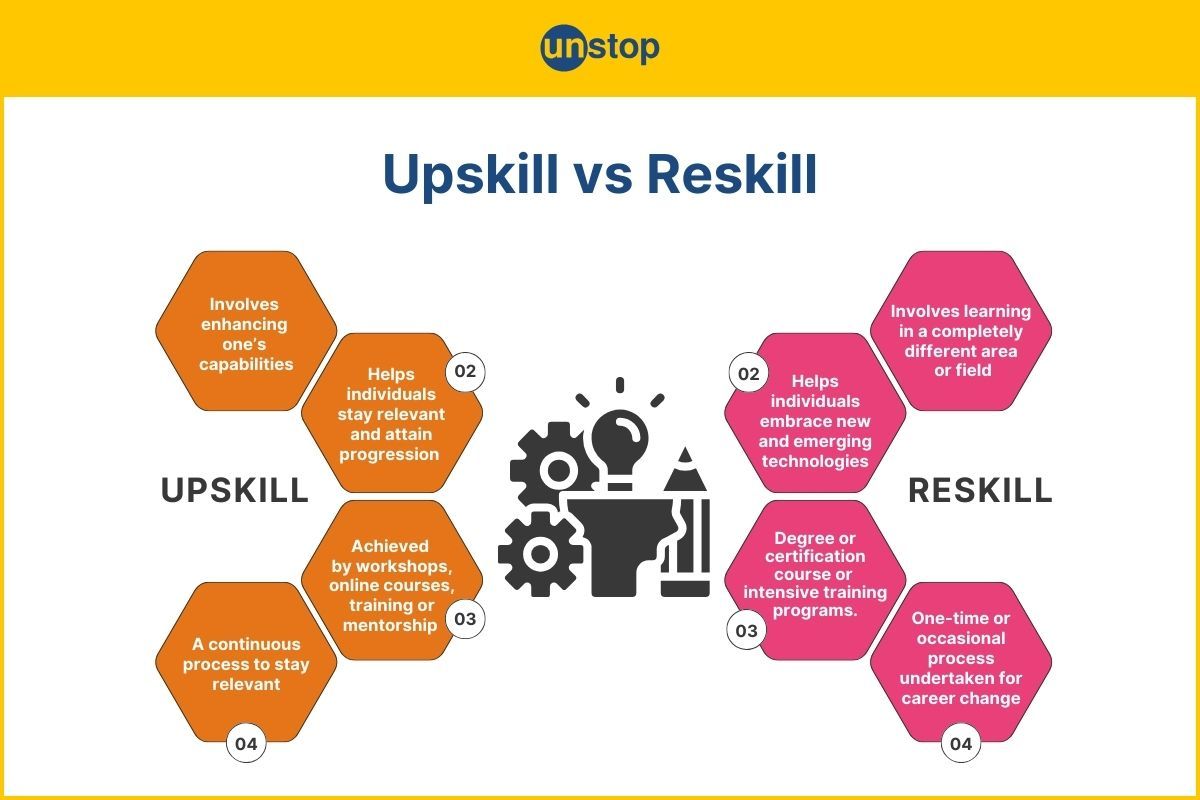
To thrive in the ever-evolving job market where skills quickly become outdated, continuous learning is an absolute must. This implies that individuals need to upskill and reskill themselves i.e. acquire new skills and expand existing ones to stay relevant and competitive.
By upskilling and reskilling, individuals can significantly boost their career prospects. With the growing demand for adaptable skills, employers value professionals who are willing to learn and adapt to changing circumstances. Investing time and effort into new skilling initiatives allows individuals to expand their knowledge base, enhance their expertise, and increase their marketability.
Dive in to understand what these skills mean, how they impact professional development, and how they differ from each other.
What Is Upskill And Reskill?
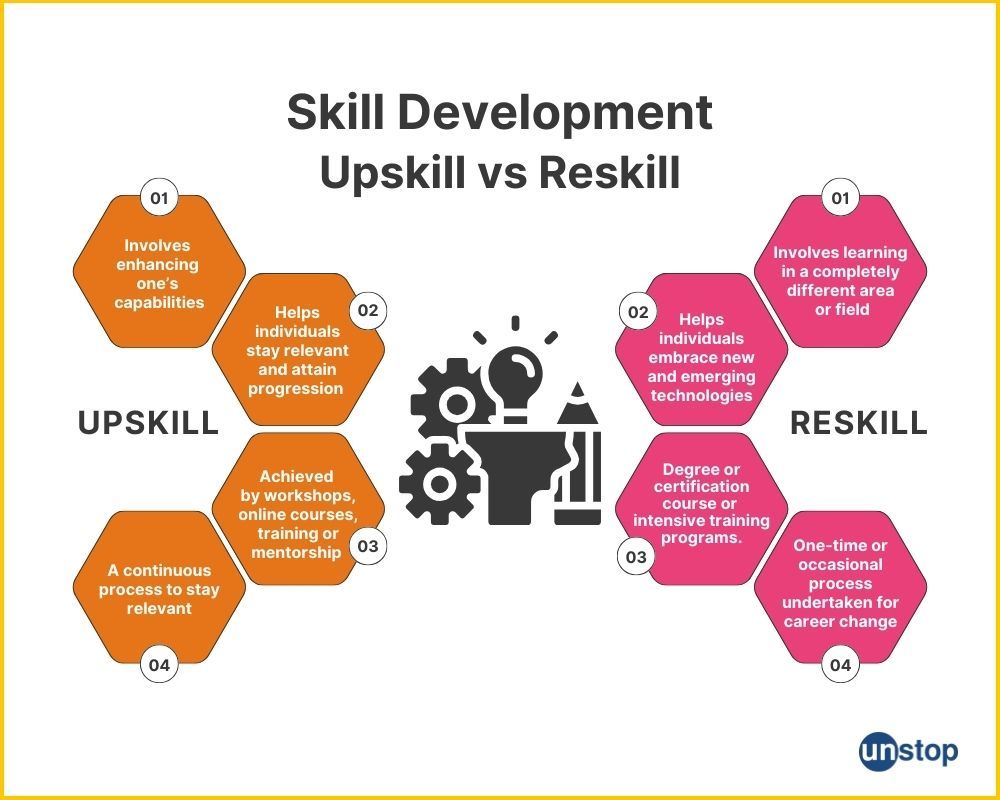
Upskill and reskill are learning approaches that professionals can embrace to future-proof their careers, enhance their employability, and increase their chances of success in an ever-changing workplace landscape. Let’s understand these processes:
Upskilling
Upskilling refers to the process of building upon existing expertise or improving specific skills within a particular field or industry. It involves gaining additional knowledge, training, or certifications to enhance one's current skill set. This enables individuals to stay up to date with the latest advancements and trends in their chosen profession.
Why do we need it?: By acquiring additional expertise related to their current role, professionals can improve their productivity and efficiency while also increasing their value as employees. This not only boosts confidence but also opens up opportunities for career advancement and higher-paying positions within the same industry.
Upskilling example: a graphic designer might choose to upskill by learning new software programs or improving their proficiency in web design.
Reskilling
Reskilling involves learning entirely new skills that may be unrelated to an individual's current field of work. It requires individuals to acquire knowledge and abilities in a different area altogether, enabling them to transition into a new role or industry.
Why do we need it?: With reskilling individual can adapt to emerging industries and take advantage of new job opportunities that align with their interests and aspirations.
Reskilling example: Someone working in finance might decide to reskill themselves as a data analyst by learning programming languages and data analysis techniques.
Both processes are essential for professional growth and staying relevant
In today's rapidly evolving job market, where technological advancements and industry trends can quickly render certain skills obsolete, both upskilling and reskilling are crucial for maintaining professional relevance. Upskilling allows individuals to stay competitive by continuously improving their existing skill set, while reskilling enables them to adapt to new challenges and pursue alternative career paths.
Difference Between Reskilling And Upskilling
Upskill and Reskill: two terms often used in the context of professional growth and staying relevant in today's rapidly changing job market. While they both involve acquiring new skills, there are distinct differences between the two.
| Criteria | Upskilling | Reskilling |
|---|---|---|
| What does it mean? | Upskilling involves enhancing one's capabilities to perform better in their current role or to take on new responsibilities within the same field. | Reskilling involves learning new skills or acquiring knowledge in a completely different area or field. |
| How does it help? | Upskilling helps individuals keep up with technological advancements, industry trends, and evolving job requirements. | Reskilling helps individuals embrace new and emerging technologies. |
| How can it be achieved? | Upskilling can be achieved through various methods such as attending workshops, taking online courses, participating in training programs, or seeking mentorship from experienced professionals. | Reskilling often requires more extensive training and education, as individuals need to acquire a completely new set of skills and knowledge. This may involve pursuing a degree or certification in a new field or undergoing intensive training programs. |
| Nature of the process | Upskilling is often seen as a continuous process that individuals engage in throughout their careers to stay relevant and continually improve their skills. | Reskilling is typically a one-time or occasional process that individuals undertake when they decide to make a significant career change or when their current job becomes obsolete. |
Upskilling for Workplace Advancement
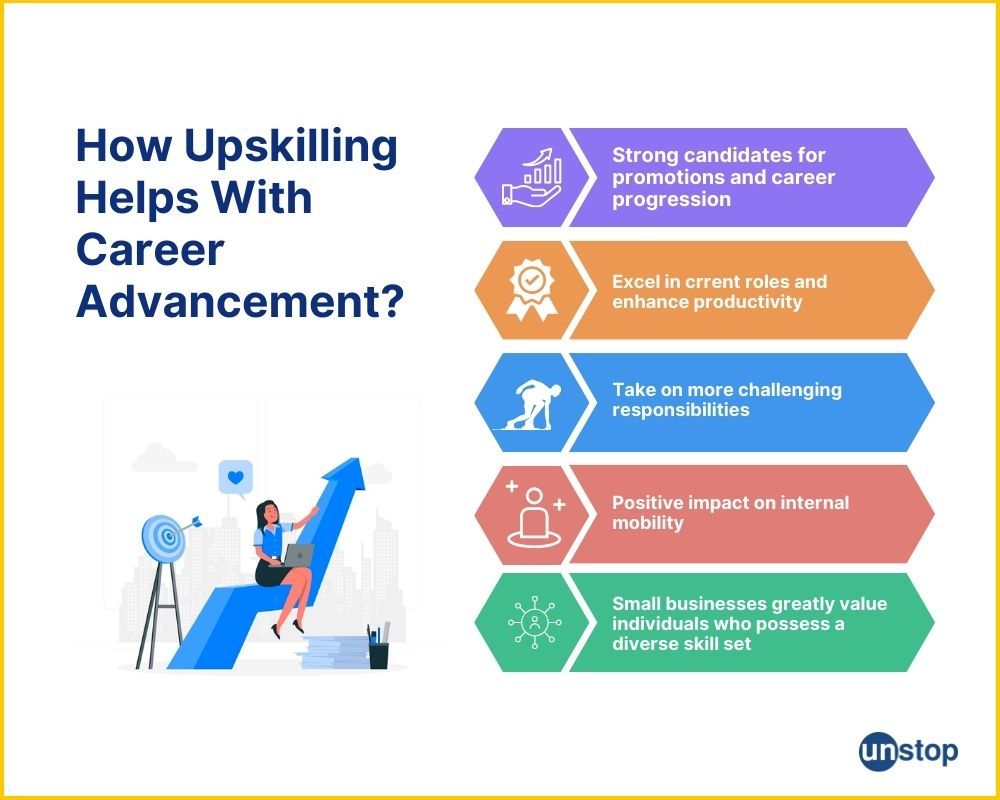
Many employers recognize the importance of upskilling and offer various opportunities for personal growth and development. They may provide training programs, workshops, or even financial support for further education. Employees should actively seek out these opportunities as they can greatly enhance their skill set while gaining recognition from their employer.
Upskilling benefits the individual and contributes to the growth and success of the organization. Here’s how:
Promotions and Career Progression
By acquiring advanced skills and knowledge, employees become more valuable assets to their employers. This positions them as strong candidates for promotions and career growth opportunities. Employers are often looking for individuals who have taken the initiative to develop new skills and bridge any existing skills gaps.
Excel in Current Roles
By honing existing skills or acquiring new capabilities, employees get better at performing their assigned tasks. This increases productivity and demonstrates a commitment to continuous improvement. As a result, individuals become indispensable team members who consistently deliver high-quality work.
Challenging Responsibilities
Upskilling also opens doors to taking on more challenging responsibilities within an organization. When employees possess the right skills and expertise, they become prime candidates for tackling complex projects or leading teams. This not only expands their professional horizons but also showcases their ability to adapt and grow in dynamic work environments.
Impact on Internal Mobility
In addition to promotions within one's department, upskilling can also have a positive impact on internal mobility within an organization. When employees acquire new skills that align with other departments or roles within the company, they become more versatile and can explore new career paths. This not only benefits the individual by expanding their horizons but also allows organizations to tap into their existing talent pool before seeking external hires.
Small Business Advantage
For individuals working in small businesses or startups, upskilling is even more essential. With limited resources and a need for multi-skilled employees, small businesses greatly value individuals who possess a diverse skill set. By upskilling, employees can contribute to multiple areas of the business and play a vital role in its success.
Reskilling for Career Transformation
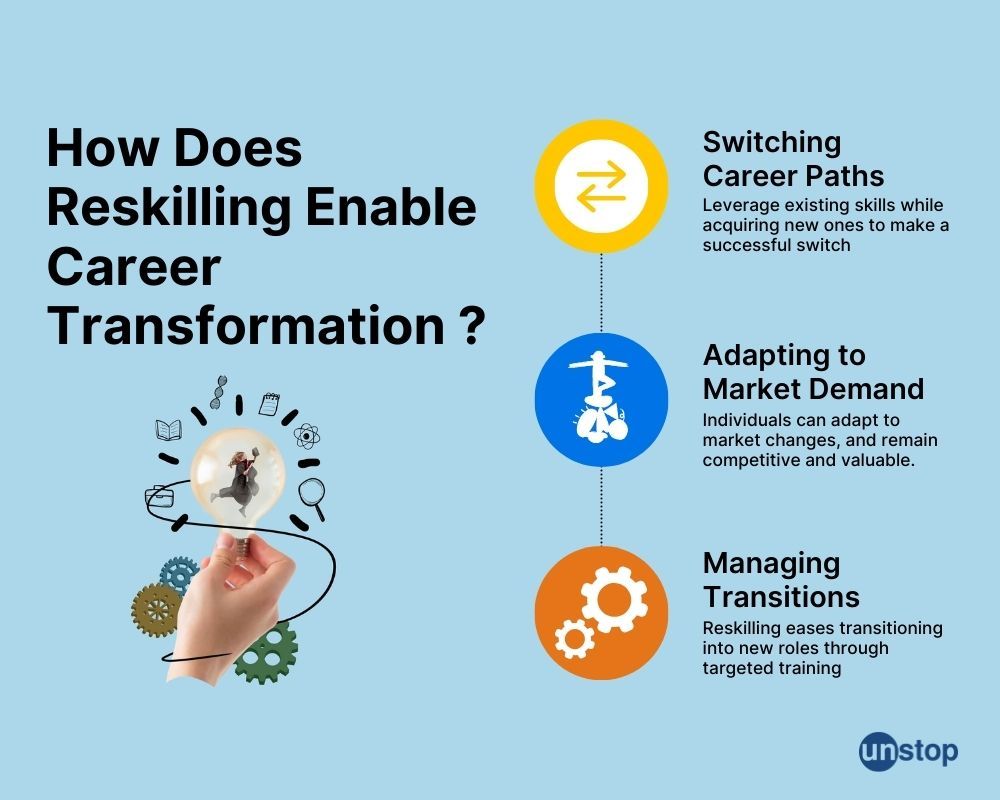
The world of work is constantly evolving, and individuals must adapt to stay ahead. By embracing reskilling, individuals can position themselves for career transformation and take advantage of emerging opportunities.
Switching Careers and Exploring New Industries
Reskilling offers a pathway for individuals looking to make a career change or venture into unfamiliar industries. It enables professionals to leverage their existing skills while acquiring new ones that align with their desired career path.
For example, someone working in finance may decide to reskill in data analytics to transition into the field of data science. By investing time and effort into targeted training programs, they can bridge the gap between their current skill set and the requirements of their desired role.
Adapting to Changing Market Demands
Reskilling provides a means for professionals to adapt and meet the evolving needs of employers. By identifying emerging trends and understanding market demands, individuals can strategically choose which skills to acquire through reskilling programs. This proactive approach ensures that they remain competitive and valuable in their respective fields.
For instance, areas such as artificial intelligence (AI) or cybersecurity are in high demand. By undertaking relevant reskilling courses or certifications in these domains, individuals can position themselves as sought-after candidates in high-growth industries.
Overcoming Challenges Associated with Transitioning Roles
Transitioning into unfamiliar roles often comes with its own set of challenges. Reskilling can help overcome these obstacles by providing targeted training tailored specifically for the desired role or industry. These programs offer practical knowledge and hands-on experience that equip individuals with the necessary tools to succeed in their new endeavors.
For instance, someone looking to transition from a managerial role to a technical position may face challenges related to technical expertise. By enrolling in a reskilling program that focuses on the required technical skills, they can gain the necessary knowledge and confidence to excel in their new role.
Crafting Successful Upskill and Reskill Strategies
Organizations should focus on developing comprehensive strategies that empower employees to upskill and reskill. Let’s take a look at how organizations can do this:
Personalized Learning Paths
To encourage employees to upskill and reskill, organizations can tailor the training programs to individual goals and organizational needs. Employees are more likely to engage with such training material and apply their new skills effectively. This approach recognizes that each person has unique strengths, weaknesses, and aspirations, allowing them to focus on areas that will have the greatest impact on their professional growth.
Identifying Key Skill Gaps
To prioritize training initiatives effectively, it is essential to identify key skill gaps within teams or departments. By conducting thorough assessments and evaluations, organizations can pinpoint areas where employees lack proficiency or require additional development.
This analysis enables targeted training efforts that address specific needs, ensuring that resources are allocated efficiently and effectively. Decision-makers can thus, align training initiatives with long-term business objectives, while also addressing immediate needs.
An innovative approach to assessing competencies can be business simulations.
Involving Employees when Designing Program
Soliciting input from individuals who will be directly impacted by these initiatives fosters a sense of ownership and engagement. Employees can provide valuable insights into their own professional goals, preferred learning styles, and areas where they feel they need additional support. This collaborative approach ensures that training programs are relevant, meaningful, and impactful.
Evaluating Training Methods
Evaluating the effectiveness of different training methods is vital for optimal results in upskilling and reskilling programs. Workshops, mentoring programs, e-learning modules - these are just a few examples of the various approaches available. By assessing which methods yield the best outcomes for different skill sets or learning styles, organizations can tailor their strategies accordingly. This evaluation process ensures that employees receive training in a format that resonates with them best, maximizing knowledge retention and application.
Upskill And Reskill Strategizing: Things to Keep in Mind
The Role of HR
Collaboration between HR and employees is crucial for driving skill development initiatives:
- HR identifies training needs and aligns them with organizational goals.
- HR supports employees throughout the upskilling and reskilling process by providing resources and guidance.
- Soft skills are a focus area for HR, as they are essential for success in the workplace.
- HR facilitates effective onboarding for new hires to ensure a smooth transition into their roles.
- Ongoing learning opportunities are provided by HR through workshops, webinars, or conferences.
- HR creates career development plans tailored to individual aspirations and organizational objectives.
Invest in Agile training methods
Upskill and reskill are important for professional development but need to be balanced with work commitments. That’s where agile training comes in:
- Agile training methods cater to diverse learner needs.
- Agile training requires moving away from traditional classroom-based training and embracing flexible approaches that allow employees to learn at their own pace.
- Organizations can utilize online online platforms, virtual classrooms and microlearning to promote a flexible approach to professional learning and development.
Role of Technology in Reshaping Industries
Automation has streamlined processes and increased efficiency in many sectors. However, it also means that certain tasks previously performed by humans are now being automated. While some may view this as a threat to job security, it also presents an opportunity for individuals to upskill and reskill themselves.
For example, someone working in the manufacturing industry may choose to learn programming languages such as Python or robotics to stay ahead of the curve and adapt to the increasing automation within their field.
Organizations can invest in field-wise simulations to assess and train employees - like simulations in economics, strategy, HR, etc. This will not only help them understand how employees are responding to technological changes but also enable them to develop adequate training modules.
Choose from a variety of business simulations, available on Unstop's assessment platform.
Measuring the Impact of Skill Development Initiatives
Organizations can measure the impact of skill development initiatives to gain valuable insights into the effectiveness of their upskilling and reskilling programs. It allows them to identify areas that require improvement while also highlighting successes that can be replicated across different teams or departments. Here’s how to measure the impact:
Implementing Metrics for Assessment
By establishing clear benchmarks and performance indicators, organizations can evaluate the success of their skill development efforts. These metrics may include factors such as employee engagement, productivity levels, and overall job satisfaction.
Additionally, by tracking key performance indicators (KPIs) before and after implementing upskilling or reskilling programs, organizations can identify any notable advancements in areas such as task completion time, quality of work, or customer satisfaction ratings.
This analysis provides tangible evidence of how skill development initiatives directly contribute to enhancing individual and team performance.
Evaluating Return on Investment (ROI)
Evaluating the return on investment (ROI) is crucial for justifying continued investment in skill development. Organizations need to determine if the resources allocated towards upskilling and reskilling are yielding positive outcomes.
ROI calculations may involve comparing the cost incurred in implementing training programs with measurable benefits such as increased revenue, reduced turnover rates, or improved employee retention. This evaluation helps organizations make informed decisions about allocating resources for future skill development initiatives.
For example, a company that implemented a comprehensive data analytics training program could evaluate its success by measuring employee adoption rates of new analytical tools or assessing how effectively individuals apply their newly acquired skills to solve complex business problems. Such evaluations provide concrete evidence that demonstrates how investing in skill development positively impacts organizational goals.
The importance of skill development cannot be overstated, as it enables individuals to stay relevant, adapt to new technologies and job requirements, and unlock opportunities for career advancement. Upskilling allows employees to enhance their existing skills, while reskilling offers the chance to acquire new skills for career transformation. Agile training methods have emerged as effective approaches to meet the dynamic needs of the workforce, ensuring continuous learning and growth.
Frequently Asked Questions
1. What do you mean by the terms, upskill and reskill?
Upskill is the process of acquiring new skills or enhancing existing ones to stay relevant in a changing job market. Reskilling, on the other hand, involves learning entirely new skills to transition into a different field or occupation.
2. Why is upskilling and reskilling important?
In today's rapidly evolving work landscape, upskilling and reskilling are crucial for professionals to adapt to emerging technologies and industry trends. It helps individuals remain competitive, increases employability, and opens doors to new career opportunities.
3. How can individuals upskill or reskill?
To upskill or reskill effectively, assess your current skill set and identify areas that require improvement. Research relevant courses, certifications, or training programs that align with your goals.
Explore certification courses, masterclasses and more at Unstop Pro and find ways to upskill and reskill.
4. How can employers help with upskilling and reskilling?
Many employers recognize the importance of upskilling their workforce and provide opportunities for employees to acquire new skills. Some organizations offer internal training programs, tuition reimbursement for external courses, mentorship initiatives, or partnerships with educational institutions.
5. Are there any financial assistance options for upskilling and reskilling?
Yes, several financial assistance options exist for individuals seeking to upskill or reskill. Government-funded programs like grants or scholarships may be available based on eligibility criteria. Some companies offer reimbursement schemes for employees who undertake relevant professional development activities.
Suggested Reads:
I’m a reader first and a writer second, constantly diving into the world of content. If I’m not writing or reading, I like watching movies and dreaming of a life by the beach.
Login to continue reading
And access exclusive content, personalized recommendations, and career-boosting opportunities.
Subscribe
to our newsletter
Blogs you need to hog!
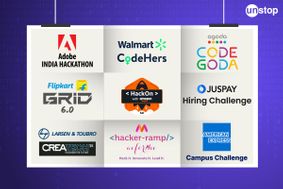
Organize Hackathons: The Ultimate Playbook With Past Case Studies

What is Campus Recruitment? How To Tap The Untapped Talent?
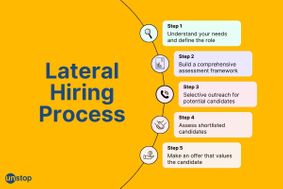
Lateral Hiring: A Complete Guide To The Process, Its Benefits, Challenges & Best Practices
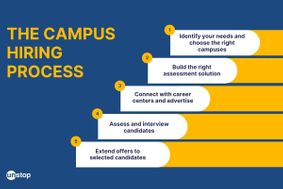












Comments
Add comment